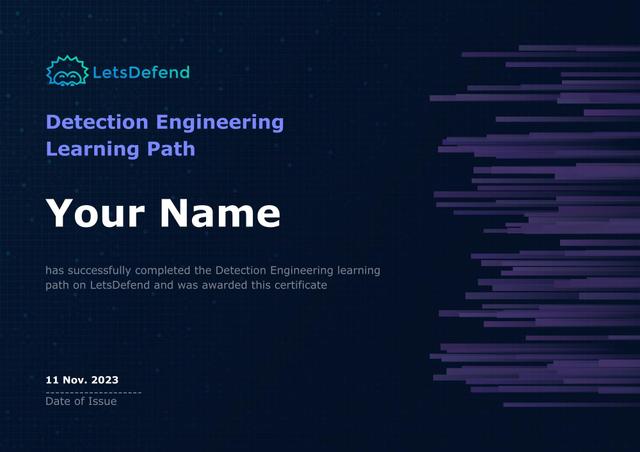Path
Badge
Certificate
Detection Engineering Path
Detection Engineering: Advanced cybersecurity training focusing on threat detection tools, incident response, and advanced log analysis for experienced cybersecurity professionals
1
9 Lesson, 21 Question, 1 Quiz
2
10 Lesson, 14 Question, 1 Quiz
3
8 Lesson, 15 Question, 1 Quiz
4
6 Lesson, 11 Question, 1 Quiz
5
7 Lesson, 11 Question, 1 Quiz
6
7 Lesson, 12 Question, 1 Quiz
7
6 Lesson, 10 Question, 1 Quiz
8
6 Lesson, 10 Question, 1 Quiz
9
5 Lesson, 9 Question, 1 Quiz
10
7 Lesson, 16 Question, 1 Quiz
11
7 Lesson, 13 Question, 1 Quiz
12
6 Lesson, 13 Question, 1 Quiz
13
5 Lesson, 13 Question, 1 Quiz
14
6 Lesson, 19 Question, 1 Quiz
15
6 Lesson, 14 Question, 1 Quiz
16
5 Lesson, 11 Question, 1 Quiz
17
6 Lesson, 16 Question, 1 Quiz
18
9 Lesson, 18 Question, 1 Quiz
19
7 Lesson, 9 Question, 1 Quiz
20
4 Lesson, 7 Question, 1 Quiz
21
4 Lesson, 10 Question, 1 Quiz
22
6 Lesson, 10 Question, 1 Quiz
23
5 Lesson, 8 Question, 1 Quiz
24
5 Lesson, 8 Question, 1 Quiz
25
4 Lesson, 5 Question, 1 Quiz
26
7 Lesson, 9 Question, 1 Quiz
27
8 Lesson, 16 Question, 1 Quiz
28
5 Lesson, 6 Question, 1 Quiz
29
6 Lesson, 6 Question, 1 Quiz
30
4 Lesson, 6 Question, 1 Quiz
31
5 Lesson, 5 Question, 1 Quiz
32
4 Lesson, 4 Question, 1 Quiz
33
5 Lesson, 6 Question, 1 Quiz
Your Progress
Steps0 of 33
Achievements
"Detection Engineering Learning Path" Certificate "Detection Engineering Learning Path" Badge
"Detection Engineering Learning Path" Badge
 "Detection Engineering Learning Path" Badge
"Detection Engineering Learning Path" Badge
Expected OutcomesProficiency in Threat Detection Tools: Gain expertise in using various threat detection tools such as SIEM (Security Information and Event Management), IDS/IPS (Intrusion Detection/Prevention Systems), and endpoint detection tools.
Understanding of Threat Landscapes: Develop a deep understanding of the current threat landscape, including malware, phishing, ransomware, and other common cyber threats.
Log Analysis and Interpretation: Acquire skills to analyze and interpret logs from various sources to identify and respond to potential security incidents.
Creation and Implementation of Detection Signatures: Learn how to create custom detection signatures or rules for different tools to identify specific threats and attacks.
Incident Response and Handling: Gain knowledge of incident response procedures, including containment, eradication, recovery, and post-incident analysis.
Network Traffic Analysis: Understand how to analyze network traffic for anomalies and potential security threats using packet capture and analysis tools.
Behavioral Analytics and Anomaly Detection: Learn how to identify abnormal behavior patterns in networks and systems that could indicate potential security breaches.
Intended AudienceCybersecurity Professionals: Individuals already working in the field of cybersecurity seeking to specialize in threat detection, enhance their skill set, and advance their careers.
Security Analysts: Those responsible for monitoring, analyzing, and responding to security incidents within an organization.
Incident Response Teams: Individuals involved in incident response, aiming to strengthen their abilities to detect and respond to security incidents efficiently.
Security Operations Center (SOC) Personnel: Individuals working in a SOC environment, dealing with real-time threat monitoring and response.
PrerequisitesBasic Understanding of Cybersecurity: Familiarity with fundamental cybersecurity concepts, terminology, and common threats such as malware, phishing, and social engineering.
Networking Fundamentals: Knowledge of networking protocols, network architecture, and understanding of how data flows across networks.
Operating Systems: Basic proficiency in operating systems like Windows, Linux, including file systems, command line interfaces, and system administration.